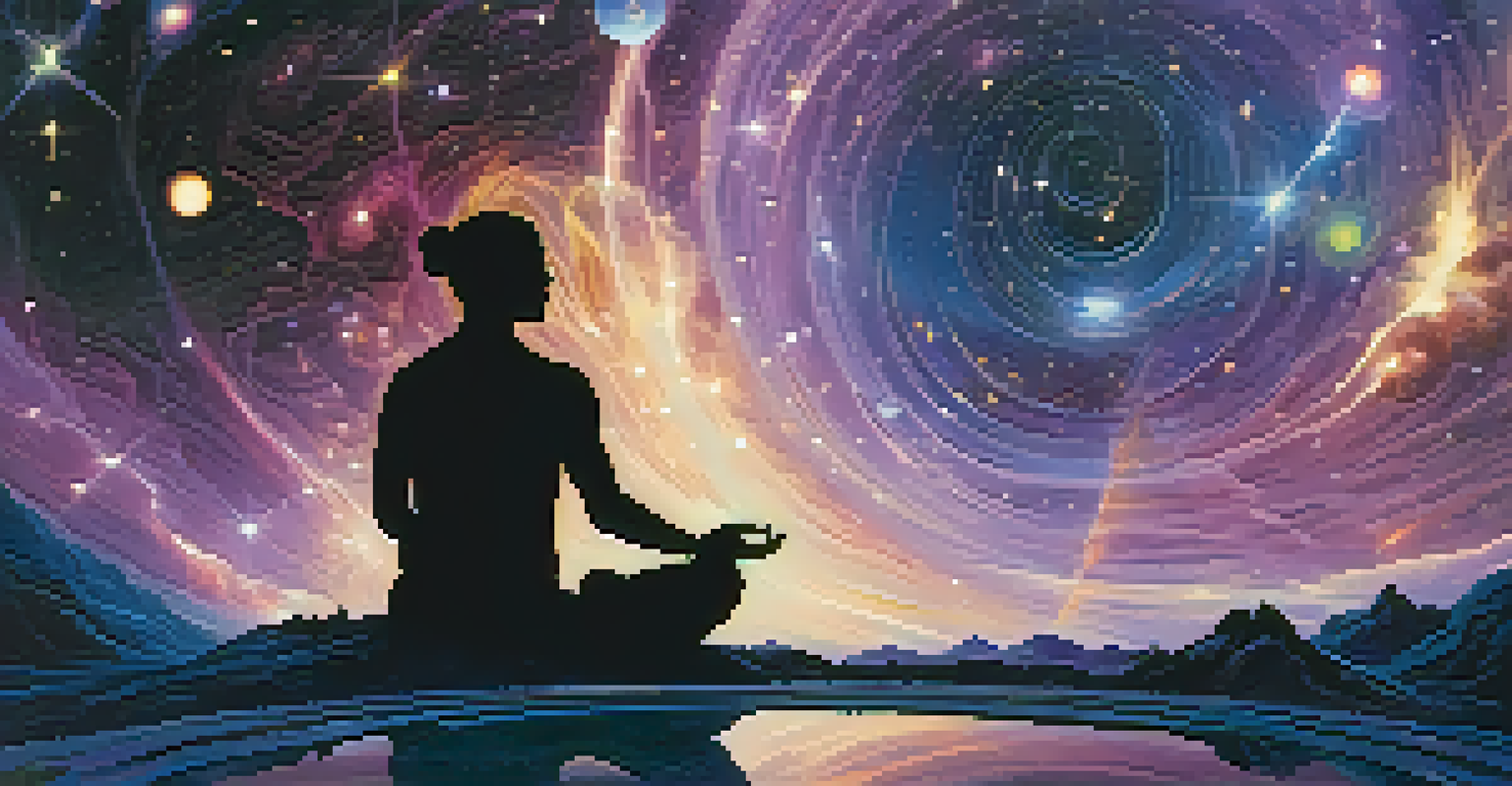Understanding Hallucinogens and Non-Dual Awareness Connections

What Are Hallucinogens and Their Effects?
Hallucinogens are a class of substances that alter perception, mood, and cognitive processes. Common examples include LSD, psilocybin mushrooms, and DMT. These substances can induce vivid visual and auditory hallucinations, as well as profound changes in thought and emotion.
The experience of non-duality is not something that can be understood through the intellect, but rather something that can be directly experienced.
Users often report experiencing enhanced sensory perception, time distortion, and a feeling of connectedness to the universe. It's as if the mind opens up to new realities, allowing individuals to explore thoughts and feelings that may remain hidden in everyday life. This can lead to both enlightening and challenging experiences.
While many people seek out hallucinogens for recreational or therapeutic purposes, it's important to approach them with caution. The effects can be unpredictable, and set and setting play crucial roles in shaping the experience. Understanding these factors helps ensure a safer journey into altered states of consciousness.
The Concept of Non-Dual Awareness Explained
Non-dual awareness is a philosophical concept referring to a state of consciousness where the distinction between self and other dissolves. It's about experiencing reality without the filters of ego or personal identity. In this state, individuals often feel a profound sense of unity with everything around them.

This awareness transcends the usual dualistic thinking, which categorizes experiences as good or bad, self or other. In non-dual awareness, these distinctions blur, allowing for a more expansive view of existence. It's akin to seeing the world through a lens that doesn't separate but instead connects.
Hallucinogens Alter Consciousness
Hallucinogens like LSD and psilocybin can induce profound changes in perception, mood, and cognitive processes, leading to vivid hallucinations and expanded awareness.
Practices like meditation and mindfulness can cultivate non-dual awareness, making it accessible to those who seek deeper understanding. Many people describe this state as liberating, as it can lead to a reduction in suffering and a sense of inner peace.
How Hallucinogens Induce Non-Dual Awareness
Research suggests that hallucinogens can facilitate non-dual awareness by disrupting the brain's default mode network. This network is responsible for self-referential thinking and the sense of ego. When it's suppressed, individuals may experience a shift in consciousness that aligns with non-dual perspectives.
In the midst of movement and chaos, keep stillness inside of you.
During a hallucinogenic experience, users often report feelings of oneness with nature and the cosmos. This can manifest as a profound sense of connection, where the boundaries of self dissolve into the larger fabric of existence. It’s a journey into interconnectedness, where separateness feels like an illusion.
Such experiences can lead to lasting changes in perspective, often prompting individuals to reassess their values and relationships. This shift can encourage more compassionate behavior and a deeper appreciation for life, highlighting the potential of hallucinogens as tools for personal growth.
The Role of Set and Setting in Hallucinogenic Experiences
Set and setting are critical concepts in understanding how hallucinogens affect individuals. 'Set' refers to a person's mindset, including their expectations and mood, while 'setting' encompasses the physical and social environment in which the experience takes place. Together, they shape the nature of the hallucinogenic journey.
For instance, a calm, supportive environment with trusted friends can foster positive experiences, whereas a chaotic or hostile setting may lead to anxiety or fear. This emphasizes the need for careful preparation and intention when embarking on a hallucinogenic exploration.
Set and Setting Matter
The mindset ('set') and environment ('setting') play crucial roles in shaping the hallucinogenic experience, influencing whether it is positive or negative.
Creating a conducive environment can enhance the likelihood of accessing non-dual awareness, allowing individuals to fully immerse themselves in their experiences. By being mindful of set and setting, one can navigate the complexities of hallucinogens more effectively.
Therapeutic Uses of Hallucinogens
In recent years, there's been a resurgence of interest in the therapeutic potential of hallucinogens. Studies indicate that substances like psilocybin and MDMA can significantly alleviate symptoms of depression, PTSD, and anxiety. This has sparked a new wave of research into their applications in mental health treatment.
Therapeutic sessions often involve guided experiences where patients can confront difficult emotions and memories. The non-dual awareness that may arise during these sessions can facilitate healing by promoting acceptance and integration of past traumas. It's as if the mind can finally release burdens that have long been held.
Though promising, it's essential to approach these treatments cautiously and under professional supervision. Understanding the profound effects of hallucinogens, combined with the principles of set and setting, can help ensure a safe and effective therapeutic process.
Potential Risks and Considerations
While hallucinogens can offer transformative experiences, they also carry risks. Not everyone is suited for these substances; individuals with a history of mental health issues may be more susceptible to adverse effects. It's crucial to recognize these potential challenges before engaging with hallucinogens.
Some users may experience difficult trips, characterized by anxiety or paranoia, which can be overwhelming. These experiences can lead to lasting psychological effects, emphasizing the importance of preparation and support during such journeys. Having a trusted guide can make a significant difference.
Therapeutic Potential Explored
Recent studies highlight the therapeutic uses of hallucinogens in treating mental health issues like PTSD and depression, emphasizing the importance of professional guidance.
Additionally, the legal status of hallucinogens varies widely, which can complicate access to safe and controlled environments for exploration. Staying informed about local laws and regulations is essential for anyone considering these substances.
Embracing the Journey: Integration of Experiences
Integration is a vital aspect of the hallucinogenic experience, especially when it comes to insights gained during non-dual awareness. It involves reflecting on the experience and finding ways to incorporate new perspectives into daily life. This process can be transformative, adding depth to one's understanding of self and reality.
Journaling, therapy, and discussions with supportive friends can aid in this integration. By articulating thoughts and feelings, individuals can make sense of the often profound and intricate experiences that arise during hallucinogenic journeys. This helps ground the insights gained, turning them into actionable wisdom.

Ultimately, embracing the journey of integration not only honors the experience but also enhances personal growth. As individuals weave these insights into their lives, they may find a deeper connection to themselves and the world around them.